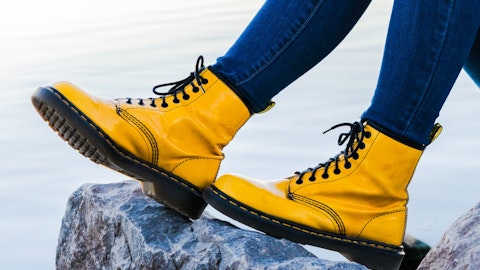Ashley Owens: Great. That’s super helpful color. Thank you.
Alex Wiseman: Thanks, Ashley.
Operator: Thank you. Our next question comes from the line of Sam Poser with Williams Trading. Please proceed with your question.
Sam Poser: Thanks very much for taking my questions. I have a question about the Wolverine brand and the work business. That’s been – can you give us some idea of why that became so tough and how you intend to get it turned around. I think as you know, the – were customers very, very loyal. And so if they – how hard will it be if they’ve gone to somebody else on the down trend and then getting them to swing back over if you [indiscernible]?
Chris Hufnagel: Yes. Great question, Sam, and I appreciate it. And I appreciate you talking about our work group. No doubt, our work group is struggling a bit right now. We’ve talked about that. The Wolverine brand specifically has been an industry leader, but we had a tough year there for sure, and we have lost share. Working really closely with that team to understand where those share losses are happening, we are seeing more at the premium price points than at the $90 to $120 alert [ph] price point. There are new introductions coming this year to bolster that more premium positioning DuraShocks, the Surge, the Colorado Equipped. We feel good about those and our ability to gain back at that $140 to $60 price point. We think inventories are much better now in the channel.
And in some places, I think, our sell-throughs are outpacing sort of the restocks and our ability to get close to that market and replenish that business. We do think the category is going to grow. But I think, Sam, to your point that has been sort of a very sort of steady on business for us, very consistent. We’ve struggled there a little bit over the past year. And there is an intense focus to get that work group back to its more historical range. I think the team has diagnosed the issues. What we did, what was self-inflicted, and then our ability to understand both channel and price point and category and then capitalizing those trends, there is a strong western trend right now. And the brand is pushing into that western trend as well. But we certainly think that premium price point is where the brand has felt some pressure.
Sam Poser: Thanks. I mean, I am just trying to wrap my arms around the expectation. It sounds like you are expecting parts of the business to turn positive in the back half of the year. Can you give us a little more dissecting of that and then just sort of delve into sort of how it gets there?
Mike Stornant: Well, again, in the guide we provided, Sam, this is Mike, Merrell is expected to inflect the growth in the back half of the year. We saw, as Chris mentioned, on Sweaty Betty, a contraction in Q1. And so again, we’ll see that sequentially improve and inflect to growth in the back half of the year as well. Our Saucony business will improve each quarter. But for the full year, we’ll be down. So we’re not expecting an inflection of growth there, but just sequential improvement. It’s important to underscore too, many of the – certainly, the business model change that we called out and some of the other changes that were mentioned in our previous discussion heavily impact Saucony, but that joint venture change is about a $30 million impact to the Saucony revenue specifically.
But overall for the year, seeing sequential improvement in Saucony but not an inflection to growth in the back half of the year. So, for the growth brands, that’s sort of the trajectory of the business. And I think Chris touched on some of those reasons to believe as it relates to the product pipeline and some of the easier comparisons, but also just the abatement of some of the headwinds that we’ve been contending with for the last couple of quarters.
Chris Hufnagel: And I think also, just to build that, we’ve also made some tough decisions as it relates to how we’re going to manage our brands. And I think how we want – our ability to reset the business and just manage the portfolio differently. Another thing working against Saucony they had a very low margin sort of value channel product that we are moving away from that wasn’t helping build brand equity that was not accretive to the brand’s margin in total, and we’re making the tough decisions to move past those businesses. So I think there is a lot of different reasons why the business is where it is. But in total, as we think about how to best manage the portfolio, how to best be great brand stewards, I think, we are making a lot of those very tough decisions right now and then working to really improve the product pipeline, investment is back into marketing to ultimately become really good brand builders.
So that’s just another reason why I’m trying to explain some of the color behind the numbers.
Sam Poser: Thank you. And then one last thing, on the gross margin, I understand like sort of the non-repeating pieces with freight, and so on and so forth. But with promotional activity, and I understand inventories are most cleaner, and so on, and I understand what’s going on today, but you are anticipating, it looks like for gross margin really to look – well, I mean the guidance is gross margin is going to look a lot better throughout the whole year and specifically in the back half when it did get very promotional. I doubt it will be as promotional as it was a year ago, but I mean how confident are you even with clean inventory that the new product you put out there is going to be good enough not to get caught up, or should you be being even more conservative with sales to sort of guarantee that, that doesn’t happen?
Chris Hufnagel: I will take it and Mike can add on. I think certainly, to your point, Sam I think, we are viewing the marketplace differently in how we manage the brands. I do think the product we have is really good. And I would say the product we introduced in 2023, I think, our innovation fell flat in 2023, and I think, the consumer responded to newness, and we were heavy in core styles that didn’t check which put a lot of pressure on 2023 and certainly continue to put pressure on us in the first quarter of this year. But when I look across the portfolio and the work that we’ve done around the product pipeline, I am encouraged by what we have both what we have hit in the marketplace today. The Ride, Guide 17 and Saucony are a good example, the Triumph will quickly follow it.
The Moab Speed 2 out of the gate is very good. The new wrapped collection, which I keep referencing, really selling out with almost no marketing because it is just visually disruptive and just looks different and it is a variant brand. So I think the product pipeline is much, much stronger than where we have been historically, and I am excited to sort of continue to work through those older core styles and get to the newness. That’s where the consumer is responding. That’s what the retailers are telling us is working what they want. And in fact, we have a new protocol every Tuesday, just a full deep dive into the business, and we had our session yesterday, and we’re having different conversations. We’re talking about chasing new products. We’re talking about – perception that we have seen, feedbacks that we’re getting, and we’re actually talking about chasing products in our supply chain today, where we haven’t had those conversations for a while.
I get on the plane next week with the Presidents of Merrell and Saucony to go to Vietnam, to go to our biggest factories, both to accelerate products that are in development and talk about how we can continue to chase other items. So the fact that we’re talking about chasing new good styles and chasing products that we want to accelerate into the pipeline, I think is a very encouraging place for us to be right now.
Mike Stornant: And the only thing I’d add to that, Sam, is really important part of the margin expansion is the hard work that the profit improvement team has done over the last year to get product costs and freight rates and things down. Not just the transitory costs that go away, but just on the go-forward business and the new styles that Chris is talking about coming in at a much higher gross margin. So really secured that and see that in the gross margin bridge. And we’re being cautious on the promotional cadence to your point. We don’t control or have complete visibility to the back half of the year. We expect it to improve because of healthier inventories, but we’re still being cautious in this guide as it relates to promotions. So I think overall we’re laying out a very achievable gross margin outlook for the business.
Operator: Thank you. Our next question comes from the line of Mitch Kummetz with Seaport Global Securities. Please proceed with your question.
Mitch Kummetz: Yes, thanks for taking my questions. I guess a couple of things on the Merrell inflection to growth, I just want to better understand that. I know you don’t give backlog. But does the order book support that growth or is this more your assumptions around DTC or at once based on the product pipeline and are retailers – are you starting to see kind of a bottoming around the outdoor space in terms of retail orders? And I have follow-up.
Chris Hufnagel: Yes. I think I’ll hit it and I’ll let Mike add some color. I think part of the turnaround and one of the things that I talked about on the last quarterly call was just how close we were to the wholesale market, how close we were to the partners. I do think the conversations are different today than they were just a handful of months ago. As we think about the outdoor category specifically and frankly how they view Merrell within their assortment. I think we all know that the pressures are well documented in the outdoor category. Merrell continues to be the leader, continues to gain share, and we keep seeing retailers keeping protecting Merrell. I think the important thing for the Merrell brand is to evolve behind that sort of classic Moab 3 silhouette and become lighter and faster and more athletic, which is why we’re so excited about how the Moab speed 2 has been received and then our entree into trail run.
And the fact that we’re gaining share in trail run is very encouraging. I think we’re paying very close attention to our own direct-to-consumer business too and what’s happening in our 46 Merrell outlet stores. Where is traffic? What are they buying? What are they responding to? We’re working to be less promotional at merrell.com. And we’re seeing sort of great increases in product margin to be less promotional and certainly to create less disruption in the marketplace. And I think Merrell has new introductions coming for the balance of the year. And then continued health, we’ve got continued health of the Moab franchise. We talked about the Jeep [ph] launch last year, 70 million impressions. The [indiscernible] sold out to the piece and we saw a 12% lift across the rest of the Moab franchise just by bringing that new heat to that category.
So I think, like I said, I think the pressure in outdoor is it remains. Hopefully that will bottom out and it’ll begin to resuscitate. At the same time, we just can’t sit back and say it is what it is. The leader has to innovate, and I think we’re bringing product to market that is very good.
Mitch Kummetz: And then Chris, on Saucony, you seem particularly encouraged, not just from a product standpoint, but also in terms of the brand heat. I’m just trying to reconcile that with the guidance that the brand doesn’t inflict to growth in the back half. Would it if you adjust for those business model changes, and if not, is really the issue that you need to get the like – the order book is the order book. The hope is that with better product, stronger brand heat, the sell through will dramatically improve and that will eventually drive better selling.
Chris Hufnagel: Yes, great question. Saucony is near and dear to my heart right now. I think Saucony has probably some of the greatest potential in the entire portfolio to have to break out. I think there’s a lot of things working against Saucony from a top line standpoint. We talked about some of them, the end-of-life transactions, the low margin business. We talked about the model changes. I’m encouraged by Saucony because I think the product pipeline is very good. And I think the brand has a very long period of time been sort of myopically focused on sort of both the Elite runner and the Elite channels and Elite products. And I think the democratization of innovation is where there is a tremendous opportunity. And so I think the new products we’ve launched are resonating well with the feedback we’re getting and we’re prelining new styles is very positive.
And there’s frankly just a broader lifestyle opportunity beyond that core runner. We’ve worked hard on colors and materials to make our shoes more approachable and we’re opening the apertures. We think about distribution. As we think about some of our new product launches, they’ve placed in sort of top 10 list and run specially where Saucony hasn’t been for years. And so we’re encouraged by those. And then if you just go back to the Elite runner, when you look at Saucony counts at the prominent marathons, Saucony is one of the top brands day in and day out in those leading marathons. And then there’s just a broader lifestyle opportunity as well. And I think that as we think about lifestyle, it’s not just that originals or retro tech.
It’s also just everyday Saucony run, which I think has tremendous opportunities. So I’m very bullish on Saucony. That category has the most momentum. There are some brands that have done phenomenally well there. We know that we have underperformed. At the same time, I think we’ve attacked the product piece first and that is encouraging. And we will be turning on the marketing. And I think as we think about the $30 million of incremental investment, I think a significant portion of that will be directed to Saucony. So I’m bullish on Saucony. I’m bullish on that team, and I think the opportunity is there.
Operator: Thank you. Our next question comes from the line of Mauricio Serna with UBS. Please proceed with your question.
Mauricio Serna: Great. Good morning and thanks for taking our questions. Just a clarification on the margin guidance for first quarter of 2024. I think I heard a 3.5 operating margin. How much would that imply in terms of like an expansion versus the ongoing business in 2023? And then if I think about your revenue guide, when you talk about an inflection in the second half, does that imply like, sales growth already happening as a total company level by third quarter? And then just lastly, on the adjustments that you provided in the presentation, just want to make sure like the 35 million in the Active Group, is that mainly because of the Xtep JV sale that you announced late last year? Thank you.
Mike Stornant: Let me take the last question first. That’s correct. So 35 million referenced is related predominantly for the Xtep change that we’ve moved to a distributor model there with that partner, effective January 1. The operating margin, I think, was your first question. The operating margin relative to the ongoing business going forward is down in the first quarter versus last year. The gross margin is up dramatically. But as we cycle through the year, obviously, we expect the operating margin to go from that 3.5% rate, which we’re seeing in Q1 on the lower revenue base. Q1 will be our lowest revenue quarter of the year to 7% for the full year. So we’ll see obviously sequential improvement there. But importantly, Mauricio, the focus for us has been to drive that gross margin expansion, have that be a sustainable improvement for the business.
That gives us the confidence and capacity to reinvest behind our brands. 46% obviously, for the first quarter is well above the full year guidance of 44.5%. So really strong outcome for the first quarter even on that lower revenue base. But importantly, much cleaner base of revenue in the first half, which is helping to drive that margin expansion.
Mauricio Serna: All right. Thank you very much.
Chris Hufnagel: Thank you, Mauricio.
Operator: Thank you. We have reached the end of our question-and-answer session. And this also concludes today’s conference. And you may disconnect your lines at this time. Thank you for your participation.



